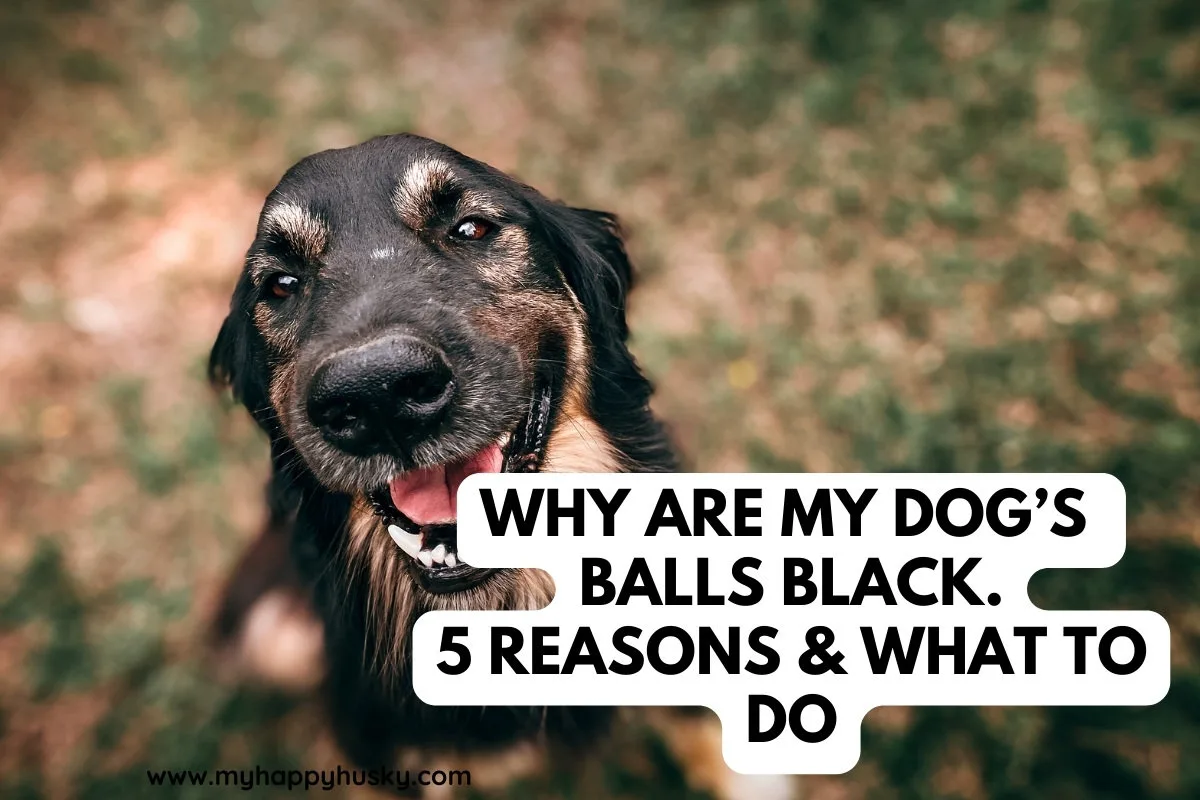Ever noticed a change in the color of your dog’s testicles and wondered, “Why are they turning black?” You’re not alone in this. It’s a common query among pet parents. Let’s explore the top five reasons behind this and what steps you can take.
In most cases, if your dog’s balls are turning black it will caused by one of five reasons including the natural aging process, testicular cancer, excessive licking, hormanl changes, skin issues, or melanoma.
While this all sounds scary, it’s not always a cause for concern! Read below to understand exactly what you need to know and when to see a vet.

1. Natural Aging Process
It’s a Part of Growing Older: As dogs age, it’s normal for their scrotum to darken. This change is often due to genetics and is a natural part of the aging process. No need for alarm if your senior pup shows this sign!
2. Testicular Cancer
A Serious Concern: Blackening of the testicles can sometimes signal testicular cancer. Symptoms include hyperpigmentation and swelling. Although rare, it’s crucial to be vigilant. If you notice these signs, a vet visit is necessary to rule out this serious condition.
3. Excessive Licking
Irritation and Discoloration: Dogs often lick their genitals, but excessive licking can cause darkening of the skin. This might be due to irritation from saliva or an underlying issue like dry skin, allergies, or a urinary tract infection. Keep an eye on how often your dog licks this area.
4. Hormonal Changes and Skin Conditions
Spots and Pigmentation Changes: Hormonal fluctuations, especially in younger dogs, can lead to dark spots on the testicles. Skin conditions, infections, or trauma might also cause these changes. Regular checks can help you spot any unusual developments.
5. Melanoma and Other Skin Issues
Rare but Possible: In some cases, black spots on your dog’s testicles could be melanoma, a type of skin cancer. This is more likely if the spots are raised or irregularly shaped. Other skin issues like fungal or bacterial infections can also cause discoloration.
Should You Visit The Vet Right Away After Noticing This?
Absolutely, yes! When you notice a change in the color of your dog’s testicles, it’s best to schedule a visit with your vet promptly.
While it could be something benign like age-related changes, it might also indicate a more serious health issue, like testicular cancer or a skin infection.
It’s essential to get a professional opinion to rule out any serious conditions. Early detection and treatment can make a significant difference in your dog’s health.
So, if you spot any changes, don’t wait – a quick check-up can give you peace of mind and ensure your pup’s well-being.
What To Do Next
Observation and Veterinary Advice: If you notice changes in your dog’s testicles, the first step is to observe any other symptoms like swelling, behavior changes, or increased licking.
Next, consult your vet. They can provide a proper diagnosis and treatment plan, ensuring your dog’s health and well-being.
Preventative Measures and Regular Care
Keep Them Healthy: Regular vet check-ups, good nutrition, and plenty of exercise can prevent many health issues. Keep an eye on your dog’s hygiene and grooming too, as this can reduce the risk of infections and skin problems.
What Experts Say
VCA Hospitals provide valuable insights into various conditions that could cause changes in the appearance of a dog’s testicles, including color changes. Here are some key points from their articles:
- Testicular Tumors: Most dogs with testicular tumors do not show obvious clinical signs. However, certain types of tumors, like Sertoli cell tumors, can lead to symptoms like feminization, which includes changes like enlarged mammary glands, hair loss, and hyperpigmentation (darkening) of the skin. These tumors can also cause behavioral changes and physical symptoms such as anemia.
- Cryptorchidism (Retained Testicle): Dogs with cryptorchidism, a condition where one or both testicles are not descended, are at a higher risk of developing testicular cancer. The risk is estimated to be at least ten times greater than in dogs with normally descended testicles. This condition can lead to complications like spermatic cord torsion, causing pain and requiring emergency surgery, and it increases the likelihood of developing cancerous tumors.
- Brucellosis: In male dogs infected with brucellosis, a bacterial infection, epididymitis can develop, leading to an enlarged scrotum or testicle and possibly a skin rash on the scrotum. In chronic cases, the testicles may atrophy or shrink. This infection can also lead to infertility in dogs.
These conditions underscore the importance of consulting a veterinarian when you notice any changes in your dog’s testicles, including color changes. A vet can accurately diagno
Conclusion
Seeing your dog’s balls turn black can be worrying, but understanding the reasons helps you respond effectively. Remember, when in doubt, your vet is your best resource for ensuring your furry friend’s health and happiness. Stay observant and proactive about your dog’s health, and you’ll both be just fine!
Disclaimer
The advice given in this article is for educational purposes only and does not constitute professional advice in any context. Before making any decisions that may affect the health and/or safety of your dog, you should always consult a trained veterinarian in your local area. For the FULL disclaimer Visit HereCopyright Notice: The content produced and published on My Happy Husky is unique and original. My Happy Husky makes an active effort to search for plagiarized content using plagiarism detection software. If plagiarized content is found, action will be taken.
